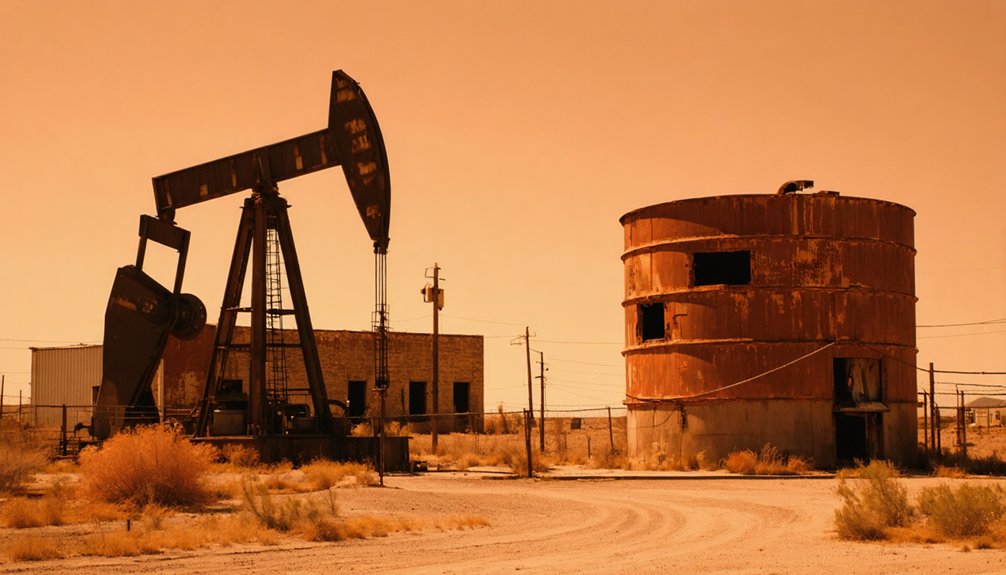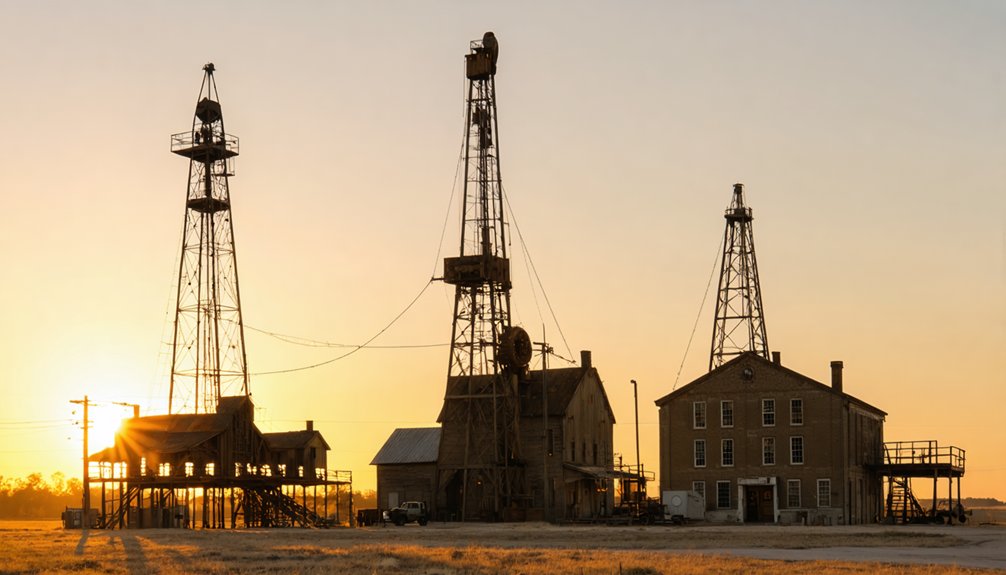Across America, you’ll discover seven haunting oil town ruins that tell stories of boom-and-bust cycles. California’s Mentryville, West Virginia’s Volcano, Louisiana’s Oil City, and Alaska’s Kennecott showcase America’s resource extraction history. Nevada’s Rhyolite, West Virginia’s coal-focused Nuttallburg, and Pennsylvania’s Oil Region Heritage sites reveal industrial prosperity’s fleeting nature. These weathered monuments face preservation challenges while offering glimpses into the environmental consequences and human narratives that shaped America’s industrial landscape.
Key Takeaways
- Mentryville, California operated for 114 years (1876-1990) as California’s first successful commercial oil venture before becoming a ghost town.
- Volcano, West Virginia boomed to 4,000 residents in the 1840s before a catastrophic fire destroyed its wooden oil facilities and infrastructure.
- Oil City, Louisiana employed 25,000 workers by 1910 but declined after the state’s 1970 oil production peak.
- Abandoned oil towns often feature preserved historic structures, industrial ruins, and environmental challenges from orphaned wells.
- Former oil boomtowns increasingly turn to heritage tourism and preservation to revitalize economies while documenting America’s petroleum history.
Mentryville: California’s Pioneering Oil Ghost Town
When Charles Alexander Mentry struck oil at Pico Canyon on September 26, 1876, he unknowingly laid the foundation for California’s first successful commercial oil venture and the birth of an iconic ghost town.
This pioneering discovery established Mentryville, a thriving community that grew to house over 100 residents at its peak. You’ll find it was remarkably progressive for its era—the first Southern California town illuminated by natural gas.
The oil field’s 114-year continuous operation (1876-1990) stands as the longest on record.
Following Mentry’s death in 1900 and the Great Depression’s impact, Mentryville’s decline began. By the 1960s, this once-bustling hub stood largely abandoned.
Today, it’s preserved as a state park and national landmark, its weathered structures—Pico Cottage, Mentry’s mansion, and Felton School—silent testimonies to California’s transformative oil history. The town later became a popular filming site for numerous movies and TV shows including “The Color Purple” directed by Steven Spielberg. Visitors can explore scenic hiking trails that lead to Johnston Park and offer breathtaking views of the Santa Susana Mountains.
Volcano: West Virginia’s Fiery End to an Oil Boom
While California’s Mentryville weathered a slow decline over decades, West Virginia’s oil boomtown of Volcano met a dramatically different fate.
Emerging from 1840s oil discoveries, Volcano rapidly grew to 4,000 residents, becoming pivotal in America’s early petroleum industry with its 28°-35° API gravity crude commanding $4-$12 per barrel. The town flourished along the major Burning Springs anticline that concentrated oil resources in the region.
The landscape transformed as wooden derricks extracted over 1,300 weekly barrels during its peak years. The town hosted two newspapers, the Volcano Lubricator and Walking Beam, which provided essential business information for the thriving oil industry.
- The catastrophic fire originated in a downtown business, swiftly consuming the wooden structures and flammable oil facilities.
- Remote terrain and absence of firefighting resources made containment impossible.
- Despite attempts at recovery, the town ultimately disappeared from existence by mid-20th century.
- Volcano’s dramatic end exemplifies the inherent vulnerabilities of early oil boomtowns dependent on combustible materials.
Oil City: Louisiana’s Slowly Deteriorating Petroleum Past
Unlike the dramatic fiery demise of Volcano, West Virginia, Oil City, Louisiana has experienced a gradual deterioration that mirrors the state’s broader petroleum industry decline.
Unlike Volcano’s fiery end, Oil City slowly fades as Louisiana’s petroleum dreams quietly rust away.
You’ll find Oil City’s origins in the 1905 drilling by the Savage brothers, which transformed this northwestern Louisiana settlement into a bustling “wildcat town” employing 25,000 workers by 1910.
The economic decline began after Louisiana’s oil production peaked around 1970, leaving abandoned infrastructure and mounting job losses in its wake.
Despite its historical significance as part of Louisiana’s petroleum heritage—preserved in the State Oil and Gas Museum—Oil City exemplifies the challenging aftermath of resource dependency.
Environmental impacts from decades of extraction have degraded surrounding wetlands and water quality, while extreme weather events increasingly threaten aging facilities.
Hurricane Katrina and Hurricane Rita in 2005 delivered catastrophic damage to Louisiana’s oil and gas infrastructure, further accelerating the decline of communities like Oil City.
Without effective change strategies, this once-thriving community continues to fade as its petroleum past slowly crumbles, reminiscent of the earlier Evangeline field development that first established Louisiana’s oil industry in 1901.
Kennecott: When Copper Mining Replaced Oil Dreams in Alaska
While many sought oil wealth in Alaska’s wilderness, Kennecott’s story diverged when prospectors discovered exceptionally pure copper ore in 1900, leading to one of the world’s richest mining operations.
You’ll find that the Kennecott Copper Mine, operational from 1911 to 1938, transformed a remote mountainside into a bustling industrial complex with its own mill town, railway system, and infrastructure supporting hundreds of workers.
After extracting nearly $3 billion (in today’s value) of copper before closing when deposits were depleted, Kennecott’s preserved ruins now stand as a National Landmark within Wrangell-St. Elias National Park, offering you a glimpse into Alaska’s industrial heritage beyond petroleum. The mine’s remarkable ore samples contained up to 70% pure copper, making it an extraordinarily valuable discovery at the time.
The journey to explore this historical site requires navigating the challenging 60-mile McCarthy Road, with its memorable one-lane Kuskulana River Bridge offering breathtaking views of the surrounding wilderness.
Copper Replaced Petroleum Dreams
Before Alaska became synonymous with oil wealth, the state’s resource economy shifted dramatically in the early 20th century when the discovery of exceptionally pure copper ore near Kennecott Glacier redirected industrial ambitions.
The economic shift from petroleum aspirations to copper mining dominance transformed Alaska’s development trajectory:
- The Guggenheim-Morgan partnership invested over $25 million (equivalent to $730+ million today) in infrastructure, abandoning initial petroleum dreams.
- Kennecott’s 70% pure copper ore yielded $200 million ($3 billion in modern value), becoming America’s 3rd-7th largest mine.
- The Alaska Syndicate expanded influence beyond copper into coal, salmon, and statewide infrastructure.
- This copper-focused economic change delayed Alaska’s statehood ambitions as mining interests gained political power.
You’re witnessing how a single resource discovery permanently altered Alaska’s economic destiny, replacing petroleum dreams with mineral extraction. The prospectors Clarence Warner and Tarantula Jack Smith made the pivotal discovery of malachite that would lead to this transformation. The initial exploration of the region began after the Klondike Gold Rush in 1898 prompted increased interest in the mineral potential of the Copper River Valley.
Alaska’s Isolated Mining Town
Nestled within the rugged Wrangell Mountains of Alaska, Kennecott emerged as one of America’s most improbable industrial achievements after prospectors Clarence Warner and “Tarantula” Jack Smith discovered an extraordinary copper outcropping in 1900.
This remote site yielded ore containing an astonishing 70% pure chalcocite, prompting the Alaska Syndicate to invest $25 million developing the area.
Despite extreme isolation, a complete urban center arose around the copper mining operations, featuring hospitals, stores, and recreational facilities.
Workers earned the highest mining wages in America while extracting what would become $200-300 million in copper.
The 196-mile railroad connected this wilderness operation to coastal shipping routes, creating an unprecedented industrial complex in the Alaskan wilderness.
National Landmark Status Today
The legacy of Kennecott’s mining operations lives on through its prestigious designation as a National Historic Landmark, awarded by the National Park Service in 1986.
Within Wrangell-St. Elias, America’s largest national park, you’ll find this remarkable 7,700-acre district that tells the story of early 20th-century copper mining innovation.
Four key aspects of Kennecott’s national landmark status:
- It represents the best-preserved example of historic copper mining in America.
- Preservation challenges include toxic mining waste requiring ongoing remediation.
- The iconic 14-story processing mill stands as a representation of industrial ambition.
- Guided tours now allow you to explore buildings where workers once extracted copper worth $200 million.
Despite environmental and preservation challenges, Kennecott remains a powerful symbol of American industrial heritage and frontier determination.
Rhyolite: Nevada’s Mineral Rush That Dried Up
A spectacular but short-lived mineral boom transformed Rhyolite from barren desert into one of Nevada’s most promising cities in the early 20th century.
When Frank Harris and Ernest Cross discovered the Bullfrog claim in 1904, samples yielding $665 per ton triggered an explosive rush. Within months, thousands flocked to this desert outpost.
You’ll find only ghostly Rhyolite ruins today where a thriving metropolis once stood. At its peak in 1907, the town boasted electricity, railroads, and a population of 10,000.
The Montgomery Shoshone Mine produced $10,000 in ore daily. But the Panic of 1907 exposed overvalued mines, and by 1911, operations ceased entirely.
The gold rush town emptied rapidly—only 24 residents remained by 1920. Now managed by the Bureau of Land Management, Rhyolite’s bottle houses and crumbling structures silently testify to mining’s boom-and-bust reality.
Nuttallburg: Coal’s Forgotten Legacy in Appalachia

While other coal ventures swept through Appalachia in the 19th century, Nuttallburg’s story began distinctively in 1870 when English immigrant John Nuttall purchased land at just $1 per acre along West Virginia’s New River Gorge.
This mining community quickly flourished, becoming the second in the region to ship valuable “smokeless” coal.
When you explore Nuttallburg history, you’ll find:
- A once-thriving town that housed over 300 residents, including immigrants and freed African Americans
- An economic powerhouse with 80 coke ovens processing coal that powered America’s industrial revolution
- Henry Ford’s 1920s acquisition, transforming it into a supply chain for his automotive empire
- A social fabric woven from diverse communities who built schools, churches, and a shared mining identity
America’s Oil History: Preservation Efforts and Tourism Potential
Just as coal towns like Nuttallburg left their mark on America’s industrial past, our nation’s oil history remains etched across landscapes from Pennsylvania to Texas, though often overlooked and increasingly endangered.
The Oil Region National Heritage Area exemplifies heritage preservation efforts, focusing on historical sites while pursuing economic revitalization through tourism.
You’ll find these preservation initiatives facing substantial challenges—particularly from an estimated 3.4 million orphaned wells nationwide.
These abandoned industrial remnants threaten both environmental integrity and historic sites, with Pennsylvania alone harboring up to 750,000 undocumented wells.
Despite these obstacles, small towns increasingly turn to heritage tourism as their economic salvation, transforming brownfields and historic oil infrastructure into attractions.
This delicate balance between preservation and development represents a vital frontier in protecting America’s industrial legacy while creating sustainable futures for former boomtowns.
Frequently Asked Questions
Are These Ghost Towns Safe to Visit With Children?
Ghost towns require stringent safety precautions and constant child supervision. They contain unstable structures, sharp debris, environmental hazards, and legal restrictions that make them potentially dangerous for young explorers.
What Environmental Cleanup Has Occurred at These Former Industrial Sites?
Many abandoned oil towns have undergone EPA-led cleanup efforts involving soil remediation, infrastructure removal, and containment systems. You’ll find varying degrees of site restoration, with brownfield initiatives addressing contamination for potential redevelopment.
Do Any Sites Offer Guided Tours or Overnight Accommodations?
You’ll find limited guided explorations at Mentryville Park and Bodie, but overnight lodging remains virtually nonexistent at oil ghost towns, unlike Weston’s heritage tourism accommodations or mining towns’ developed infrastructure.
Can Visitors Collect Artifacts or Use Metal Detectors?
You shouldn’t collect artifacts due to preservation laws. Metal detection typically requires permits, with unauthorized use risking fines. Consider the archaeological context and cultural significance before disturbing historical sites.
Which Locations Are Accessible for Mobility-Impaired Visitors?
You’ll find wheelchair accessibility at Bolivar Peninsula, Spindletop Museum, and Signal Hill locations, with ADA-compliant parking options. Titusville and Beaumont also offer partial accessibility for mobility-impaired visitors.
References
- https://www.loveexploring.com/gallerylist/131658/abandoned-in-the-usa-92-places-left-to-rot
- https://en.wikipedia.org/wiki/Wikipedia:Village_pump_(policy)/Archive_BL
- https://www.wideopencountry.com/the-10-eeriest-ghost-towns-in-america/
- https://en.wikipedia.org/wiki/Deepwater_Horizon_oil_spill
- https://www.atlasobscura.com/places/ghost-town-volcano-west-virginia
- https://en.wikipedia.org/wiki/List_of_ghost_towns_in_Oklahoma
- https://airial.travel/attractions/united-states/stevenson-ranch/mentryville-historic-park-MV7FD1rj
- https://en.wikipedia.org/wiki/Crude_oil
- https://www.geotab.com/ghost-towns/
- https://www.youtube.com/watch?v=4jEAZNJUXnI



